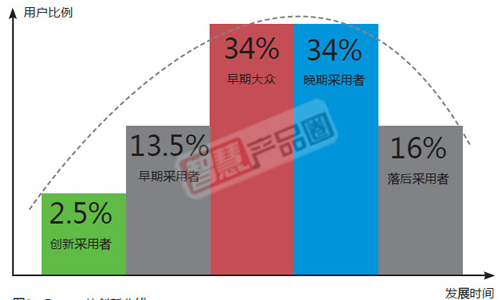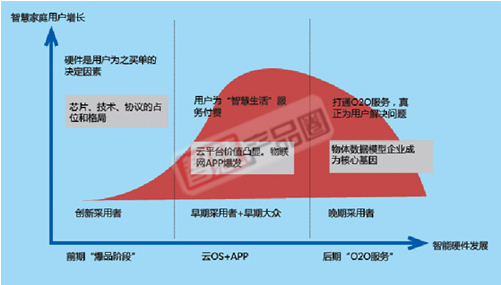Like all emerging industries and sectors, the smart home industry also follows the development of the Rogers innovation curve, and user development has gradually covered from the early technology enthusiasts to the later general public. And every breakthrough in the development phase needs to solve the core problem, either from technology or from product applications, but also from the cloud. Following the "5+3+7 architecture to support smart families", "Smart Product Circle" combines the new changes and future development stages of the industry, sorts out the characteristics and bottlenecks of each stage, and gives breakthrough suggestions based on actual cases.

Figure: Rogers' Innovation Curve
The pre-explosive stage hardware is king, chip technology grabs
The early adopters of smart homes come from digital enthusiasts, geeks and other groups, and most of them are fresh and advertised personality, but they are also the main group of product public beta, playing a role in the innovation exchange with hardware manufacturers, and attracting the attention of this group of users. It is "explosive hardware."
Explosive hardware has innovative functions, cool appearance and unlimited extension applications. The typical representative of foreign countries is Nest. There is no product with the same influence in China. It is also the focus of capital in this development stage, whether it is acquisition or investment. The domestic home furnishing manufacturer Ou Ruibo has nearly 100 million financing, and Nest has been acquired by Googles 3.2 billion. Similarly, cloud platform companies with large number of users will also cooperate with manufacturers with "explosive products" characteristics, so it is not difficult to understand why the most intelligent family members are From large and small hardware startups, smart sockets, smart light bulbs, smart routers, smart mattresses... one can't be less.
From the perspective of the industry chain (chip-hardware-cloud-APP-O2O service), the supplier-chip technology enterprise of hardware manufacturers plays an important role in the explosive stage, especially in reducing power consumption, reducing volume, and processing. The ability, sensing accuracy and hardware innovation design together provide the cornerstone for explosive hardware. Therefore, chip manufacturers have enough opportunities to lead innovation and rebuild at this stage. Qualcomm, MTK, Broadcom, and Intel... strive to gain leadership in new areas.
The medium-term "cloud OS+APP stage" forms the data standard, and the cloud begins to gather
The user base of the mid-term "Cloud OS+APP Phase" has affected early adopters and some early-stage publics. They are cautious public opinion leaders who are willing to lead fashion and try new things. It can be said that this group of people is not bad money, willing to pay for excellent products and experiences, and the improvement of family smart life is one of the areas that most people of this kind are concerned after personal consumption of electronics.
Around smart life, after enough good hardware is filled into the smart home field, the interconnection between devices becomes a new problem to be solved, because it is difficult to create a good user experience for a single product, users are more inclined to smart baby rooms, will breathe The air, safety linkage system and other such TotalsoluTIon. Achieving synergy between multiple branded products is like having people from multiple countries work together to accomplish a job. On the one hand, they need unified leadership (the goal is the same), and on the other hand, the language is connected (communication barrier-free). The role of the former in the smart home field is borne by the cloud server, while the latter requires a certain data standard specification.
At present, many companies (Internet companies, hardware companies, solution companies, etc.) have seen the value of home cloud services. The ground-moving campaign to start the expansion of the land has tried to integrate hardware, but the methods and methods are different. Some start with the unified communication module. Strongly associated with their own cloud; some start from the router to do the offline cloud portal, and add a large and full SDK to do the all-around translation; some pull the control terminal based on the single product APP, extend to do super APP. With the choice of APP for the cloud platform, just like the operating system of the mobile phone, the cloud and the cloud will be connected to each other and eventually become a larger cloud.
From the perspective of the industry chain, the most effective space for this stage will be the APP based on the home Internet of Things. The Internet of Things app is different from the game, life and social APP of pure smartphones. Developers must have hardware accumulation and Understand and apply the standard data of all kinds of intelligent hardware, and fully grasp the experience of the user scene. In addition, this stage may be subverted by the traditional business model, realizing hardware free service charges, while APP sales will also drive low-quality and high-quality hardware production growth.

Late "O2O stage" service company establishes brand and strengthens user stickiness
Late and backward adopters will choose to use smart homes after they become mainstream. People's lives are inseparable from the convenience provided by intelligence, and the conservative attitude makes them more reliable brands and word of mouth.
Platform aggregation, data standards open to a certain extent, the rapid rise of the Internet of Things APP will accelerate the development of smart home, but also face the same problems as mobile APP, software is easy to be copied and imitated. Therefore, in addition to having an excellent user experience, the development of the Internet of Things app is important to build a brand to enhance user stickiness, while offline services are the most difficult to be surpassed. It requires years of accumulation and operation, such as family community medical services, a three-kilometer radius. Family e-commerce, home security alarm system... There are already companies in advance layout.
From the perspective of the industrial chain, IoT enterprises that have developed to this stage must have the ability to open up online and offline, produce products that will digitize their lives and goods, and infiltrate them like smart genes into APP applications. Among the various hardware and software.
The four major bottlenecks will gradually improve in the development stage
Compared with the perfect smart family form, there are too many shortcomings in the current industry. There are four major bottlenecks: lack of chip technology, insufficient innovation of hardware products, immature platforms, and no service. It seems to be full of loopholes, but according to the analysis in the first three sections of this article, it is found that these problems will be encountered at every stage of development, and will eventually be resolved according to market rules.
There are still some companies that are still obsessing and observing whether they enter smart homes. They think that it is not too late to start after the real start. It is not known that several stages of development are interlocking. Intelligent hardware only has a period of market experience and user participation. Accumulation can have explosive genes; APP companies and O2O services can not only stay at the level of information interoperability, and constantly analyze and solve consumer needs and problems to bring user stickiness; and cloud companies need to constantly cooperate with various vendors. Only in this way can we find a model of IoT cloud storage, computing, and data analysis.
Whether it is chips, hardware, cloud, Internet of Things APP, O2O services, there are already more or less enterprises involved, but these companies are still in their own hands, lack of industry guidance, and are not clear about the current stage of development. I don't know how to integrate resources and cooperate. In the same period of the high-tech fair on November 19th, the speakers and industry figures of the “China Smart Home Summit Forum†organized by the Shenzhen Smart Family Association will jointly explore the road to development.
Following the successful convening last year, the second “China Smart Home Summit Forum†jointly organized by Shenzhen Smart Family Association and Siruida Media will be held again during the Shenzhen High-Tech Fair on November 19-20, 2014, from Jingdong and LeTV. , Haier, Huawei, Fengxiang, Murata, Galaxy, Oribo, Medical, Leading East, New Hechuang, Pratt & Whitney, AYLA, ZigBee Alliance, Yinglai Hechuang, Samsung Group, Lihewei, Remote Control e The top executives of the company will be the guest speakers, and will focus on the development trend of smart home industry technology, user experience, market demand and so on.
Zgar International (M) SDN BHD , https://www.zgarvapepen.com
